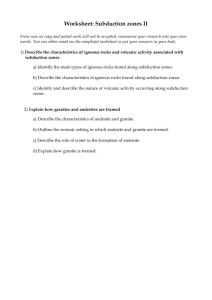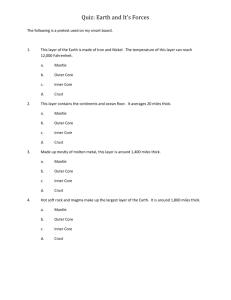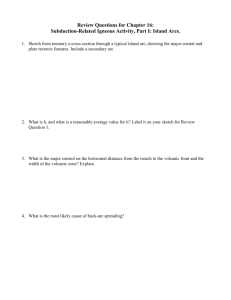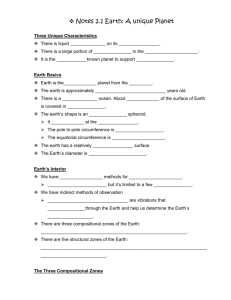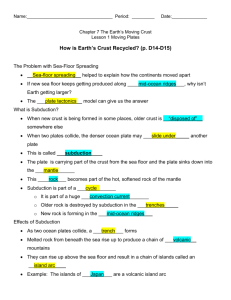Geos596F Subduction Zones: An Integrated View
advertisement
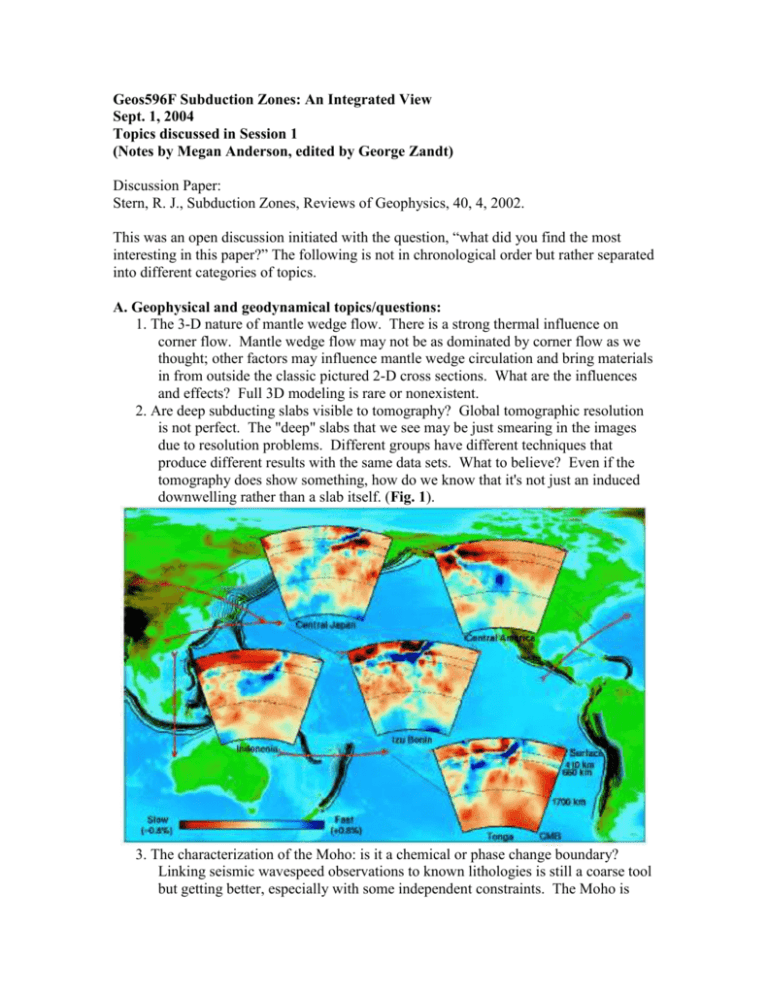
Geos596F Subduction Zones: An Integrated View Sept. 1, 2004 Topics discussed in Session 1 (Notes by Megan Anderson, edited by George Zandt) Discussion Paper: Stern, R. J., Subduction Zones, Reviews of Geophysics, 40, 4, 2002. This was an open discussion initiated with the question, “what did you find the most interesting in this paper?” The following is not in chronological order but rather separated into different categories of topics. A. Geophysical and geodynamical topics/questions: 1. The 3-D nature of mantle wedge flow. There is a strong thermal influence on corner flow. Mantle wedge flow may not be as dominated by corner flow as we thought; other factors may influence mantle wedge circulation and bring materials in from outside the classic pictured 2-D cross sections. What are the influences and effects? Full 3D modeling is rare or nonexistent. 2. Are deep subducting slabs visible to tomography? Global tomographic resolution is not perfect. The "deep" slabs that we see may be just smearing in the images due to resolution problems. Different groups have different techniques that produce different results with the same data sets. What to believe? Even if the tomography does show something, how do we know that it's not just an induced downwelling rather than a slab itself. (Fig. 1). 3. The characterization of the Moho: is it a chemical or phase change boundary? Linking seismic wavespeed observations to known lithologies is still a coarse tool but getting better, especially with some independent constraints. The Moho is indeed a seismic characterization, and it's interpretation will perhaps always remain somewhat ambiguous. People are attempting to characterize the seismic properties of lower crustal and upper mantle materials with more accuracy and more parameters (Vp, Vs, Vp/Vs, Q, anisotropy). Subduction zones can be thought of as a challenge or an opportunity because of the wide variety of chemically distinct lithologies with variable water/fluid content. 4. If we believe seismic images show slabs down deeper than the 670, is it visible because of thermal differences or chemical differences between it and the surrounding mantle? Could be thermal because recent thermal modeling indicates there should be thermal differences deep into the mantle. Or, is the “visibility” of slabs more related to composition? If the descending lithosphere is depleted, it may be higher velocity because it has lost its less mafic components (?). On the other hand, if it has melted it usually loses more iron rather than magnesium in this process, this could actually make the residue less dense and perhaps lower velocity. So perhaps the chemical processes cancel each other out. However, it was pointed out that the density of descending slabs does depend on the harzburgite/lherzolite ratio: the higher the ratio (more depleted), the less dense the slab is. So perhaps depletion does matter? B. Geochemical/petrologic topics/questions: 1. How does melt move through the mantle wedge? (Fig. 2) There seem to be three different models: porous flow, channelized flow, or diapiric ascent. Modeling of this process is still in its infancy! Percent partial melt is low: ~1% and this amount can readily escape the wedge. We think we can see partially melted mantle wedge through tomography in subduction zones (Fig. 3). 2. How important is CO2 and where does it come from? CO2 is important for climate and paleoclimate modeling and for chemical models for fluxing to generate arc magmas. Stern feels this is very important, but others are skeptical. There is a question as to where the carbon comes from, is it subducted carbonates, other subducted materials sources, or the lower crust of the upper plate? It was pointed out that the dominant volcanic lithologies produced by arcs (majority is andesite) are produced by H2O fluxing of the mantle, not CO2, therefore the source is probably the lower crust. 3. What volume of serpentine is carried into/exists in a subduction zone? Exact quantification probably hasn't been done/finished yet. Seismically, serpentine has a very low velocity but high Vp/Vs. The forearc is a place where the Moho is seismically invisible in many subduction zones and people have attributed that to the presence of large quantities of serpentine in the forearc mantle. In addition to serpentine carried in with the subducting slab, it is thought to be created in the wedge from H2O in sediments or basalt and it may stay in the wedge as well. Therefore forearc serpentines may not have a simple external source, it could be a collection of wedge serpentines caught in the forearc "eddy" of wedge flow. This may interact with or be a source of serpentines that exist along the subduction interface. 4. Serpentine seems to be a catchall for unknown problems. How important is it? It seems to be actually very important. Many observations suggest that ophiolites are loaded with serpentine so it is likely to be present in rather large quantity in subduction zones. Other phases may have water-carrying potential (e.g. amphibolites), but that potential is much smaller than that of serpentine. 5. How does thickness of the crust of the overriding plate affect magmatism? Most workers believe crustal thickness and composition is an important parameter in arc volcanism. In a simple sense, thin mafic crust allows mafic magmas to ascend rapidly to the surface. But a thick felsic crust slows or even stops the ascent of mafic magmas, leading to ponding/sills/magma bodies in which crustal melting, fractionation, and assimilation occur. 6. Does fast/slow mid ocean ridge spreading produce more/less basaltic crust and less/more serpentinized crust? The idea that oceanic crust is produced by serpentinization of the mantle goes back to Harry Hess (1962) but was largely discredited with the developing ideas of sea floor spreading and plate tectonics. But apparently newer studies have given more support to this idea and suggest that in slow spreading oceans, a preponderance of the oceanic crust is not basalt generated by magmatic processes but rather serpentinized peridotite. This could have significant “downstream” affects as this very hydrous crust is subducted. This also connects back to topic A-4. C. Mineral physics topics/questions: 1. How far down does serpentine remain stable and if it transforms, how fast does that happen? It can go deep (as phase A)! In hot subduction zones phase A is stable to 100-175 km. For cold subduction zones it goes deeper. How deep? Not sure. Kinetics are important in these type of transformations and people are still working to understand the role of kinetics in subduction zone phase transformations. 2. How do phase changes cause deep earthquakes? Phase change is a volumetric reaction, therefore that should show up in the characteristics of earthquake mechanisms. Seismologistsdon't see this, but instead observe the ubiquitous double-couple events. Therefore it is thought that the phase changes initiate earthquakes (slip) on pre-existing fault planes or weaknesses that are already under stress. At the end, we asked what were the most significant outstanding questions about subduction zones. You said: 1. How are subduction zones initiated? 2. How does slab detachment (breakoff) occur? What factors influence it? 3. Where do metals come from in arc related ore deposits? Why do we have different metals in different (parts of) subduction zones. 4. How long does it take slab fluids to ascend to the surface? How does magma move through the corner flow? 5. Rips/tears/bends/folds in slabs. 6. Sediments in trenches, where does it go? How does subduction erosion occur? 7. Are the continents growing or being recycled? 8. What are the shear stresses at subduction interfaces and how much of the subduction zone topography is due to isostacy versus dynamic effects from crust/mantle flow? 9. Deep earthquakes. 10. Deformation of the upper plate. 11. The 3rd dimension of subduction zones.



